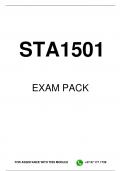STA1501
EXAM PACK
FOR ASSISTANCE WITH THIS MODULE +27 67 171 1739
, ASSIGNMENT 01
Unique Nr.: 806739
Fixed closing date: 15 May 2021
Please study Chapters 1 to 5 and corresponding parts of the study guide before answering the
following questions.
Remember that in this module, to get examination admission you must have a semester
mark of at least 40%. You semester mark is calculated as the average of the five best marks
of your 6 assignments.
This assignment consists of two parts, namely; the true/false question (part A) – 20 marks and the
written questions (part B) – 100 marks, thus the total for the assignment is 120 marks.
PART A: 20 Marks
State whether the following statements are true or false.
QUESTION 1
A qualitative variable for which there is some kind of ranking for the different values is called an
interval variable.
QUESTION 2
In general, probability samples are samples in which the elements to be selected are drawn on the
basis of probability in such a way that each element in the population has the same probability of
being selected obtained as part of the sample.
QUESTION 3
All the individual data values can be read out from a stem-and-leaf display.
QUESTION 4
As a result of surveying 1000 first year students at UNISA, it was found that 32% owned a laptop.
The value 32% is an example of a parameter.
QUESTION 5
A histogram can be used to summarise ordinal qualitative data.
2
, STA1501/011/0/2021
QUESTION 6
The interquartile range of a data set is always half of the range of the data set.
QUESTION 7
Measures of position are used to describe the position a specific data value possesses in relation
to the mean of the data.
QUESTION 8
Bias in self-selected sampling can be reduced by increasing the sample size.
QUESTION 9
Assume that the least squares line fitted trough a scatter diagram of two variables, X and Y; is
given by b
y D 5:2 0:3x: Then the coefficient of correlation for the two variables is negative.
QUESTION 10
The coefficient of correlation for a data set with two variables is always smaller than the covariance
of the same data set.
QUESTION 11
A data set can have several mode values.
QUESTION 12
The median of a data set is always equal in value to one of the original data values.
QUESTION 13
A box plot is plotted using the values of the mean, the first quartile and the second quartile.
QUESTION 14
Sampling error can be reduced by increasing the sample size.
QUESTION 15
Cluster sampling is an example of simple random sampling.
QUESTION 16
If a data set consists of only negative values, then its standard deviation is negative.
3
, QUESTION 17
If a distribution is symmetric, then the distance between first and second quartiles if roughly the
same as the distance between the second and third quartiles.
QUESTION 18
In a simple random sample, all members of the population have the same probability of being
selected.
QUESTION 19
A positively skewed data set is one where most of the values are positive.
QUESTION 20
If the covariance between two data variables is zero then the scatter diagram shows all the points
lined along a horizontal line.
PART B: 100 Marks
Study Chapter 1, 2, 3, 4 and 5 of the text book before attempting these questions. Give full
calculations, and use correct mathematical and statistical notation.
QUESTION 21
A group of UNISA students were asked what device they mostly use for accessing the myUnisa
module sites. The responses were coded as 1 for laptop computer, 2 for desktop computer and 3
for a smart phone. The following data was collected: 1, 2, 1, 1, 1, 1, 2, 2, 3, 3, 1, 2, 2, 3, 1, 3, 3, 3,
3, 3, 2, 1, 3, 1, 1, 1, 2, 2, 3, 2.
(a) Construct a table showing the frequency distribution and the relative frequency distribution
for this data. (8)
(b) Draw a bar chart of the data. Ensure you label the axes properly and give the title of the
graph. (6)
(c) What does the data tell us about the use of the different devices by the students? (2)
[16]
4




